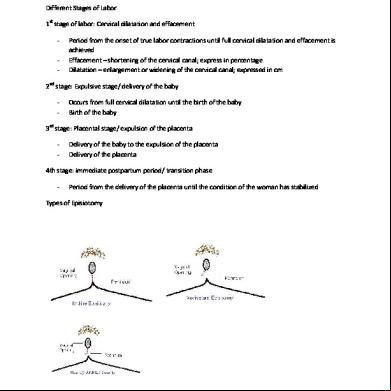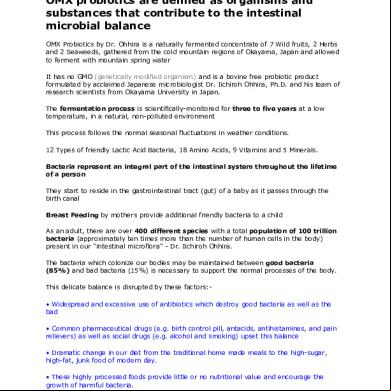Placental Transfer Of Drugs 6g265
This document was ed by and they confirmed that they have the permission to share it. If you are author or own the copyright of this book, please report to us by using this report form. Report 2z6p3t
Overview 5o1f4z
& View Placental Transfer Of Drugs as PDF for free.
More details 6z3438
- Words: 682
- Pages: 19
Placental transfer of drugs Dr. Manish Singhal 11 Feb 2008
Structure Matern al
Foetal
Placenta is a fetomaternal organ. The foetal portion is known as the villous chorion, the maternal portion as the decidua basalis.
Functions of the Placenta Transfer of products between the maternal and fetal blood Transfer of immunity by transfer of immunoglobulins from the mother Endocrine function Detoxification of drugs and substances transferred from the mother.
Mechanisms of Placental Transport
Simple diffusion----oxygen, carbon dioxide, fatty acids
Facilitated diffusion--glucose Secondary active transport----Amino acids
Active transport---Iron, Calcium,Iodine Pinocytosis----IgG Bulk transport– Electrolytes and water
Although the placenta acts as a barrier between the maternal and foetal tissues it is not a perfect barrier as it was believed to be earlier.
Substances that cross the placenta Substances Examples BENEFICIAL Gases
O2,CO2,
Nutrients
Glucose, Amino acids,FFA
Metabolites
Urea, Bilirubin, Creatinine
Electrolytes
Na, K, Cl, Ca
Maternal
Albumin,Thyroxine,Insulin
Steroid
proteins
Hormones
Immunoglobulins
Cortisol,estrogen IgG
HARMFUL Poisonous
gases
Carbon monoxide
Infectious
agents
CMV,toxoplasma,HIV etc.
Drugs Immunoglobulins
Cocaine,alcohol,phenytoin,ana estthetics,sedatives,analgesic s Anti-Rh antibodies
Rate of transfer across a membrane is governed by the Fick Principle: Q/t = K * A ( Cm – Cf) / D
Q/t is the rate of diffusion K is the diffusion coefficient A is the area of the membrane Cm-Cf is the concentration gradient D is the thickness of the membrane
Factors affecting drug transfer
Lipid solubility Degree of Ionisation pH of maternal blood Protein binding F/M concentration gradient Placental blood flow. Molecular weight of the drug
Lipid Solubility : Lipophilic molecules readily diffuse.
Degree of Ionisation: Only non-ionised fraction can diffuse
pH of maternal blood: Acts by affecting the degree of ionisation.This effect depends on the pKa of the drug
Protein binding: Unbound drug diffuses. Acidosis reduces the bound fraction
Molecular weight:
Drugs with molecular weights <600 Da readily diffuse.
Foeto-Maternal concentration ratios (F/M) of
OPIOIDS ALL OPIOIDS CROSS THE PLACENTA IN SIGNIFICANT AMOUNTS
Pethidine : It is 50% protein bound and has an
almost unrestricted placental transfer. Maximum uptake foetal uptake occurs 2-3 hours after a maternal i/m dose. Longer half lives of pethidine and it’s metabolite in the foetus hence there is a risk of cumulative Half side effects. Pethidine Norpethidi
life(hrs) Mother Foetus
4 19
ne
21 62
Morphine: Poorly lipid soluble but weakly protein bound and readily crosses placenta Fentanyl : Highly lipid soluble and rapidly crosses the placenta, but is largely protein bound(85%)
Anaesthesiology 2007;106;843-63 : Practice guidelines for obstetric anaesthesia, a report by ASA taskforce on obstetric anaesthesia : Demonstarted superiority of neuraxial anaesthesia with opioids vs parenteral opioids. Anaesthesiology Vol 104,Issue 1 (Jan’06)Ngan Kee et.al: Remifentanil at a 1mcg/kg bolus causes neonatal depression with a F/M of 0.73, neonatal resus facilities recommended. A’logy Vol 106,Issue 5 ( May ’07): Opioids istered via neuraxial route
Local Anaesthetics
Cross the placenta by simple diffusion Commonly used LA have low mol. wt., high lipid solubility and low ionisation. “Ion trapping” : Local anaesthetic accumulation in the foetus due to foetal acidosis. Transfer to the foetus is also affected by: Dose Site of istration—paracervical vs epidural Use of adjuvants like epinephrine. Highly protein bound drugs like
Inhalational agents
High lipid solubility and low mol. wt. facilitate rapid transfer. Halothane F/M 0.87 Diffusion hypoxia may occur in neonates exposed to nitrous oxide immediately prior to delivery (F/M 0.83)
Induction agents
Thiopentone : F/M 0.4-1.1 , Highly lipophilic and 75% protein bound. Rapidly crosses placenta Propofol : F/M 0.65-0.85. Exact pharmacokinetic data not available.
Muscle Relaxants
Highly ionised and poorly lipid soluble, hence DO NOT cross placenta
Anti-cholinergics
The placental transfer correlate directly with their ability to cross the BBB. Atropine rapidly crosses, Glycopyrollate is poorly transferred.
Benzodiazepines
Diazepam readily crosses. It is highly non-ionised and very lipophilic. F/M 1 within minutes of injection and reaches 2 within 1 hour. Midazolam: F/M 0.76, but has a short half-life.
THANK YOU
Structure Matern al
Foetal
Placenta is a fetomaternal organ. The foetal portion is known as the villous chorion, the maternal portion as the decidua basalis.
Functions of the Placenta Transfer of products between the maternal and fetal blood Transfer of immunity by transfer of immunoglobulins from the mother Endocrine function Detoxification of drugs and substances transferred from the mother.
Mechanisms of Placental Transport
Simple diffusion----oxygen, carbon dioxide, fatty acids
Facilitated diffusion--glucose Secondary active transport----Amino acids
Active transport---Iron, Calcium,Iodine Pinocytosis----IgG Bulk transport– Electrolytes and water
Although the placenta acts as a barrier between the maternal and foetal tissues it is not a perfect barrier as it was believed to be earlier.
Substances that cross the placenta Substances Examples BENEFICIAL Gases
O2,CO2,
Nutrients
Glucose, Amino acids,FFA
Metabolites
Urea, Bilirubin, Creatinine
Electrolytes
Na, K, Cl, Ca
Maternal
Albumin,Thyroxine,Insulin
Steroid
proteins
Hormones
Immunoglobulins
Cortisol,estrogen IgG
HARMFUL Poisonous
gases
Carbon monoxide
Infectious
agents
CMV,toxoplasma,HIV etc.
Drugs Immunoglobulins
Cocaine,alcohol,phenytoin,ana estthetics,sedatives,analgesic s Anti-Rh antibodies
Rate of transfer across a membrane is governed by the Fick Principle: Q/t = K * A ( Cm – Cf) / D
Q/t is the rate of diffusion K is the diffusion coefficient A is the area of the membrane Cm-Cf is the concentration gradient D is the thickness of the membrane
Factors affecting drug transfer
Lipid solubility Degree of Ionisation pH of maternal blood Protein binding F/M concentration gradient Placental blood flow. Molecular weight of the drug
Lipid Solubility : Lipophilic molecules readily diffuse.
Degree of Ionisation: Only non-ionised fraction can diffuse
pH of maternal blood: Acts by affecting the degree of ionisation.This effect depends on the pKa of the drug
Protein binding: Unbound drug diffuses. Acidosis reduces the bound fraction
Molecular weight:
Drugs with molecular weights <600 Da readily diffuse.
Foeto-Maternal concentration ratios (F/M) of
OPIOIDS ALL OPIOIDS CROSS THE PLACENTA IN SIGNIFICANT AMOUNTS
Pethidine : It is 50% protein bound and has an
almost unrestricted placental transfer. Maximum uptake foetal uptake occurs 2-3 hours after a maternal i/m dose. Longer half lives of pethidine and it’s metabolite in the foetus hence there is a risk of cumulative Half side effects. Pethidine Norpethidi
life(hrs) Mother Foetus
4 19
ne
21 62
Morphine: Poorly lipid soluble but weakly protein bound and readily crosses placenta Fentanyl : Highly lipid soluble and rapidly crosses the placenta, but is largely protein bound(85%)
Anaesthesiology 2007;106;843-63 : Practice guidelines for obstetric anaesthesia, a report by ASA taskforce on obstetric anaesthesia : Demonstarted superiority of neuraxial anaesthesia with opioids vs parenteral opioids. Anaesthesiology Vol 104,Issue 1 (Jan’06)Ngan Kee et.al: Remifentanil at a 1mcg/kg bolus causes neonatal depression with a F/M of 0.73, neonatal resus facilities recommended. A’logy Vol 106,Issue 5 ( May ’07): Opioids istered via neuraxial route
Local Anaesthetics
Cross the placenta by simple diffusion Commonly used LA have low mol. wt., high lipid solubility and low ionisation. “Ion trapping” : Local anaesthetic accumulation in the foetus due to foetal acidosis. Transfer to the foetus is also affected by: Dose Site of istration—paracervical vs epidural Use of adjuvants like epinephrine. Highly protein bound drugs like
Inhalational agents
High lipid solubility and low mol. wt. facilitate rapid transfer. Halothane F/M 0.87 Diffusion hypoxia may occur in neonates exposed to nitrous oxide immediately prior to delivery (F/M 0.83)
Induction agents
Thiopentone : F/M 0.4-1.1 , Highly lipophilic and 75% protein bound. Rapidly crosses placenta Propofol : F/M 0.65-0.85. Exact pharmacokinetic data not available.
Muscle Relaxants
Highly ionised and poorly lipid soluble, hence DO NOT cross placenta
Anti-cholinergics
The placental transfer correlate directly with their ability to cross the BBB. Atropine rapidly crosses, Glycopyrollate is poorly transferred.
Benzodiazepines
Diazepam readily crosses. It is highly non-ionised and very lipophilic. F/M 1 within minutes of injection and reaches 2 within 1 hour. Midazolam: F/M 0.76, but has a short half-life.
THANK YOU





